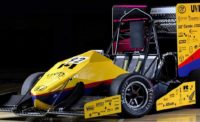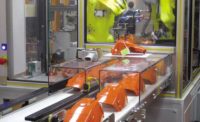Veterinarians estimate that tens of thousands of dogs worldwide are disabled due to trauma, degeneration or genetics. Increasingly, 3D-printed medical devices are being used to improve the quality of life for these animals.
In late 2012, Rita Leibinger Medical GmbH decided to improve its popular TTA (tibial tuberosity advancement) implants for dogs. These implants eliminate the need for a veterinarian to repair damaged cruciate ligaments in dogs’ hind legs by reorganizing the bone force and stabilizing the knee.
Leibinger engineers worked with those from 3D printer manufacturer 3D Systems Inc., and together they developed the TTA RAPID. Unlike the original implants, TTA RAPID does not require a large fixation plate during surgery. Instead, this titanium implant has an open structure that promotes rapid bone ingrowth and greatly lessens the risk of infection. Equally important, the implant shortens the treatment-to-recovery cycle from a few months to just six weeks after surgery.
“They [engineers] went through about four design iterations to improve the [implant] appearance,” explains Peter Mercelis, technology and application developer manager for 3D Systems. “[The new implant also] eases the surgical procedure and [lowers] manufacturing costs.”
Thus far, more than 10,000 implants have been 3D printed at Leibinger’s state-of-the-art manufacturing facility in Leuven, Belgium. Dr. Yves Samoy from Ghent University in Belgium developed the surgical technique using TTA RAPID.
Mercelis says this implant has enabled large breeds of dogs—such as German shepherds and Great Danes—to walk better, run faster, jump higher and play harder. He notes that the Leibinger and 3D engineering teams are working on scaled-down implants for smaller dogs and cats.
Separately, last year 3D Systems developed 3D-printed prosthetic legs for Derby, a Siberian husky that was born with deformed front legs. The prosthetics enabled Derby to run again with no problem.
In October 2014, Tara Anderson, director of color jet printing product management for 3D Systems, temporarily adopted the dog from Peace and Paws Dog Rescue in Hillsborough, NH, after his owners could no longer care for him. To enhance Derby’s mobility, Anderson placed Derby’s front paws on a cart. Although helpful, the cart did not provide Derby with the full motion of running. It also prevented him from playing with other dogs.
So, Anderson turned to Kevin Atkins, 3D’s freeform product manager, and Derrick Campana, ABC-certified orthotist at Animal Ortho Care, for help. Campana and the 3D team created plaster cups to hold Derby’s front legs, and then digitally scanned them with a Geomagic Capture 3D scanner. The 3D contour model was imported into Geomagic Freeform to design the prosthetic legs and digitally match them up with a CT scan of Derby’s anatomy.
Initially, the team came up with a peg leg design that didn’t work well. Anderson then went home and sketched out a prostethic featuring a spoke-and-rocker design. The team developed two of these prosthetics in the same manner, and they work wonderfully.
For more information on 3D printers, call 803-326-3900 or visit www.3dsystems.com.




